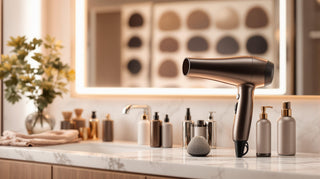Blow-drying can make or break your hair's health and style. The key is using the right tools, heat settings, and techniques tailored to your hair type. Here's what you need to know:
- Use Proper Heat Settings: Keep temperatures below 347°F to avoid damage.
- Choose the Right Tools: Ceramic dryers for fine hair, titanium for thick hair, and ionic for curly or frizzy hair.
- Protect Your Hair: Always apply a heat protectant before drying.
- Work by Hair Type: Straight hair needs sectioning and smoothing, wavy hair benefits from a diffuser, and curly/coily hair thrives with low heat and gentle handling.
Quick Comparison of Hair Types and Tools
| Hair Type | Heat Setting | Recommended Dryer | Key Products |
|---|---|---|---|
| Fine/Straight | Low (300°F) | Ceramic | Volumizing spray |
| Thick/Straight | Medium (350°F) | Titanium | Smoothing serum |
| Wavy | Low-Medium (300–350°F) | Ionic/Diffuser | Curl-enhancing mousse |
| Curly/Coily | Low (300°F) | Diffuser | Leave-in conditioner, heat protectant |
Start with these simple tips to protect your hair and achieve your desired look. Ready to dive into the details? Let’s go!
Volume Blowout: Salon Blow Dry Tutorial
Hair Types and Blow-Drying Basics
Knowing your hair type is key to choosing the right blow-drying methods and tools while keeping your hair healthy.
How to Know Your Hair Type
Your hair's traits play a big role in how it reacts to heat styling. As Board-certified Dermatologist Janiene Luke points out, "Most people do not fit perfectly into one particular type, and may find that they have different textures in different parts of their scalp".
Here's how to identify your hair's key features:
- Density and Texture: Part your hair to check density. If you can barely see your scalp, your hair is thick. If the scalp is somewhat visible, it's medium. A very visible scalp means thin hair. To assess texture, compare a strand to sewing thread: thinner than thread is fine, thicker is coarse.
-
Curl Pattern Classification: The Andre Walker system breaks down curl patterns:
- Type 1: Completely straight with no natural wave.
- Type 2: Wavy hair, ranging from loose waves to more defined ones.
- Type 3: S-shaped curls that hold their form.
- Type 4: Tight coils or kinky hair with Z-shaped patterns.
- Porosity Test: Garnier's Curly Hair Stylist Sabrina Ahmed says, "Once water is dried from the hair, it is less weighed down". To test porosity, place a clean strand in water. If it sinks quickly, your hair has high porosity. If it floats, it's low. Porosity impacts how your hair absorbs moisture and styling products.
Recognizing these characteristics will help you tackle the challenges of blow-drying more effectively.
Main Blow-Drying Problems
Different hair types come with their own blow-drying challenges. Here's a quick look at common issues and their causes:
| Hair Type | Common Problems | Primary Causes |
|---|---|---|
| Fine Straight | Limpness, static | Too much heat, heavy styling products |
| Thick Straight | Bulk, frizz | Poor sectioning, exposure to humidity |
| Wavy | Loss of wave pattern, frizz | Over-styling, incorrect heat settings |
| Curly | Disrupted curl pattern | Strong airflow, improper attachments |
| Coily | Breakage, dryness | Excess tension, lack of moisture |
Using the right tools, heat settings, and techniques tailored to your hair type can make all the difference in achieving great blow-drying results.
Tools and Products You Need
Having the right tools makes all the difference when it comes to professional blow-drying. Here’s a breakdown of what you’ll need for every hair type.
Blow Dryers and Attachments
Your hair dryer should match your hair type. Here's a quick guide:
| Hair Type | Recommended Dryer Type | Ideal Wattage | Key Features |
|---|---|---|---|
| Fine/Thin | Ceramic | 1,600W | Even heat, gentle on delicate strands |
| Thick/Coarse | Titanium | 2,000W+ | High heat for faster drying |
| Curly/Frizzy | Ionic/Tourmaline | 1,800–2,000W | Reduces frizz with negative ions |
Master Stylist Jenna Lothrop emphasizes the importance of using the right attachments to achieve the best results.
Some highly-rated dryers include:
- Dyson Airwrap Complete Long: Rated 4.8/5 on Sephora
- T3 Featherweight StyleMax: Rated 4.8/5 on Nordstrom
- Shark SpeedStyle: Rated 4.5/5 on Amazon
Pairing your dryer with proper heat protection is key to maintaining healthy hair.
Heat Protection and Styling Products
Protecting your hair from heat damage is a must.
Celebrity Hairstylist and Curl Specialist Christin Brown explains, "Heat protectants are used to literally protect the hair from damage caused by any version of heat styling - this can range from blow-outs to silk pressing to the use of curling irons and flat irons."
Here are some top-rated heat protectants tailored to different hair needs:
- Fine Hair: Living Proof Restore Perfecting Spray ($33)
- Thick/Coarse Hair: Briogeo Farewell Frizz Blow Dry & Heat Protectant Crème ($26)
- Color-Treated Hair: Olaplex No. 9 Bond Protector ($30)
Karla Marabello of K'Bello Organic Salon advises starting with the lowest heat setting to minimize damage. "Less heat means there's less risk of damaging the hair", she says. Adjust the temperature only if necessary.
sbb-itb-a50b05d
Blow-Drying Steps by Hair Type
Steps for Straight and Wavy Hair
Begin by gently patting your hair with a microfiber towel to remove excess moisture.
For straight hair:
- Pre-dry Dry your hair until it's about 80–90% dry. Hold the dryer roughly 5 inches away from your head. Use medium heat for fine hair and higher heat for thicker hair.
- Section and Style Divide your hair into sections, starting from the nape and working upward. Take 1–2 inch segments, hold them taut with a brush, and direct the dryer nozzle downward to smooth the cuticle.
For wavy hair, focus on enhancing your natural texture:
- Apply a curl-enhancing mousse, like Amika's Double Agent ($120), to damp hair.
- Attach a diffuser to your blow dryer and set it to medium heat.
- Scrunch your hair gently while drying to emphasize the wave pattern.
- Finish with a light-hold hairspray for added control.
Adjust your approach as needed to maintain the natural wave pattern.
Steps for Curly and Coily Hair
Start with sulfate-free products and detangle your hair thoroughly. Let your hair air-dry until it's about 50% dry before using any heat tools to minimize damage.
When using a diffuser, follow these steps:
| Step | Technique | Purpose |
|---|---|---|
| 1 | Use low or medium heat | Reduces heat damage |
| 2 | Place curls into the diffuser | Helps maintain curl pattern |
| 3 | Massage gently with the diffuser | Activates natural curls |
| 4 | Focus on drying the roots first | Adds volume |
| 5 | Move to mid-lengths and ends | Ensures even drying |
Work with your hair's natural texture and finish with a cool shot to lock in the style and smooth the cuticle.
Fixing Common Problems
Preventing Damage and Frizz
Addressing common hair issues starts with understanding how to avoid damage and frizz. Many traditional dryers lack proper heat control and airflow, which can harm your hair.
| Heat Setting | Hair Type | Maximum Temperature |
|---|---|---|
| Low | Fine or damaged | 300°F |
| Medium | Fine to medium | 350°F |
| High | Thick or coarse | 400°F |
"My go-to heat protectant and all-around multitasking product is the Rodan and Fields Defrizz+ Oil. This oil not only smooths the hair, it adds shine and protects hair from up to 450 degrees of heat".
"Hair can absorb up to 30% of its own weight in water. The longer it remains damp, the more it continues to swell. Repeated swelling and slow drying can break down the structure and damage it irreversibly".
Using the right heat settings is key to protecting your hair. Combine this with techniques that ensure even drying for the best results.
Solutions for Uneven Results
Uneven drying often happens when you're in a rush or don't follow your hair's natural growth patterns. Here's how to fix it:
-
Proper Sectioning
Use clips to divide your hair into even sections. This prevents overlapping heat exposure and reduces static.
"Always split your hair into clean sections. This will prevent the overlap of too much heat on your hair. Plus, overworking your hair in that way will make it all the more staticky".
-
Follow Growth Patterns
Aim the nozzle downward along the hair shaft, especially near the crown and hairline, to smooth the cuticle. -
Complete Drying
Fully dry each section before moving on. Pay extra attention to areas like the roots and nape to avoid damp spots.
For tricky cowlicks, shape them while the hair is warm, then lock the style in place with a cool shot.
Summary and Tips
Get salon-worthy results at home by tailoring your tools, methods, and heat settings to your hair type.
| Hair Type | Temperature | Essential Tools | Key Products |
|---|---|---|---|
| Fine/Straight | Low (300°F) | Small round brush | Volumizing spray |
| Thick/Straight | Medium-High (350–400°F) | Large round brush | Smoothing serum |
| Wavy | Low-Medium (300–350°F) | Diffuser | Curl-enhancing mousse |
| Curly/Coily | Low (300°F) | Wide-tooth comb, Diffuser | Leave-in conditioner |
This chart highlights the core tips from earlier sections. Choosing the right blow dryer plays a big role in achieving great style while protecting your hair.
"My go-to heat protectant and all-around multitasking product is the Rodan and Fields Defrizz+ Oil. This oil not only smooths the hair, it adds shine and protects hair from up to 450 degrees of heat".
Here are a few basics to keep in mind:
- Always use a heat protectant on damp hair.
- Work in sections, starting at the roots for better control.
- Aim the airflow downward along the hair shaft to reduce frizz.
- Finish with a cool shot to lock in your style.
"Hair can absorb up to 30% of its own weight in water. The longer it remains damp, the more it continues to swell. Repeated swelling and slow drying can break down the structure and damage it irreversibly".
Using the right techniques and quality products is the foundation for keeping your hair healthy and styled to perfection.

